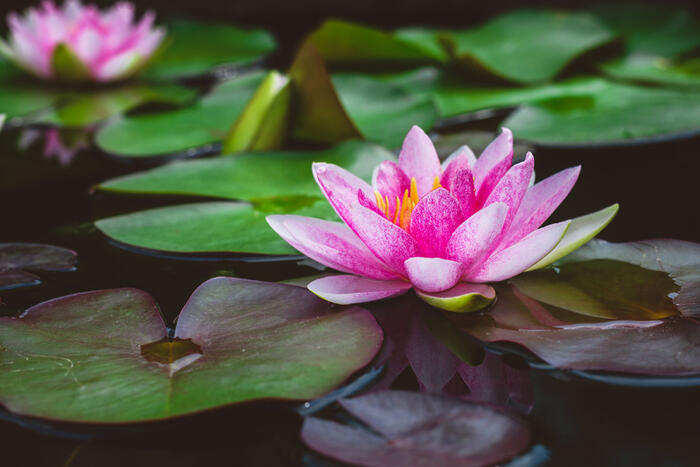Last updated on October 23rd, 2023 at 08:30 pm
A pond in your own garden is a real idyll and invites you to linger on hot summer days. But what if you have only a balcony? Then you do not have to give up the pleasure, because for this case there are balcony ponds. The mini watering holes can be easily created in various containers. We explain what you should pay attention to.
The most important in a nutshell
- A balcony pond is not recommended on north-facing balconies.
- A balcony pond is easy to create in almost any container and requires little maintenance.
- Make sure your balcony is load-bearing enough for a mini pond.
- Create a balcony pond: Here’s what you need to pay attention to
Before you enhance your balcony with a mini pond, there are a few questions to address. At the top of your list should be the load-bearing capacity of the balcony. If this is too low, the creation of a balcony pond is unfortunately impossible. In addition, you need to decide on a location and pay attention to the proper care of the balcony pond.
Contents
Balcony pond: Consider load-bearing capacity
A balcony pond means additional weight for your balcony and this should not be underestimated. For this reason, you will need a structural analysis report before you start planning. If you are renting, you must contact your landlord or the owner of the house to obtain an expert opinion. Often this is already available – if this is not the case, the owner must commission it. Clarify in advance who will pay for it to avoid disputes with the landlord. If you are the owner of the house, contact a structural engineer with your request, who will examine the load-bearing capacity of the balcony.
Not only the weight of the balcony pond plays an important role in the expert opinion. After all, you want to be able to continue using the balcony in the future. Therefore, you must include the weight of any users of the balcony and balcony furniture in the calculation.
The right location
If the load-bearing capacity of your balcony is ensured, now choose the location for your balcony pond. Choosing the right location is important, as it is a prerequisite for planting the mini pond. For example, a south-facing balcony with more than eight hours of sun a day is rather unsuitable for a balcony pond. The problem is that the water heats up too much here and can overheat, since the water surface is relatively small. The result is rapid formation of algae and poor plant growth. Against this, it helps to attach a sun sail or otherwise provide shade. If you have a north-facing balcony, a balcony pond is basically not feasible. The reason: the plants in the water need at least six hours of sun a day to survive.
Tip: Before you fill your mini pond, place the container on a furniture or plant roller. This way you can easily move the pond on the balcony. You can also attach rollers directly to some vessels.

Balcony pond care and wintering
A balcony pond does not require much care. To prevent too much algae from forming, place the mini pond in a place that is not too sunny and plant water lilies, for example. The plants will reduce the growth of algae. You can also prevent the formation of algae by regularly pruning the pond plants in spring and fishing off algae that has already grown. Change the water from time to time. However, you don’t have to replace all the water every time – 30 percent is enough.
A water pump also reduces algae growth. The pump has another advantage: by constantly circulating the water, you prevent mosquitoes from laying their larvae in your pond. When buying your water pump, make sure the unit is freeze-proof so it doesn’t break in the winter.
Submerged plants provide oxygen to your pond. However, always place them in the container with a pond basket and weigh them down with clean pebbles. By doing this, you reduce the risk of the water becoming cloudy. It also helps to remove leaves and pigeon droppings regularly. In the spring, remove the layer of mulch and cut back all plants. Fill the pond with new water, especially on hot summer days, as it evaporates heavily.
You can already winterize your balcony pond. For this, you will need winter-hardy plants as well as the freeze-proof water pump. Otherwise, you need to completely empty your mini pond in the winter and store it in the basement.
Balcony pond: Which vessel is suitable?
For your balcony pond, you can basically use any vessel that is tight and can hold water. A special eye-catcher is an old oak wine barrel. The material is very durable, but can crack over the years. Therefore, be sure to install a pond liner in wooden vessels. This also prevents wine residues from getting into the water. Also a highlight on the balcony is a zinc tub. If the sheet metal inside is completely galvanized, the tub is rust-free. Although high-quality zinc tubs do not require a pond liner, it is still a good idea to use one, as it is difficult for the layman to tell the difference in quality.
Without pond liner comes the mortar tub or planter. These are already watertight and usually do not release pollutants into the water. In addition, – especially mortar tubs – are inexpensive. However, not everyone likes the simple, black appearance of the vessel. One disadvantage: the bucket smells strongly at first.
Advantages and disadvantages of the balcony pond
The advantages of creating a balcony pond are that it is easy to maintain and you can change the water quickly and easily. The purchase is relatively inexpensive and the implementation can be done even by inexperienced do-it-yourselfers or amateur gardeners. However, the mini pond also has its disadvantages. Firstly, a balcony pond cannot regenerate itself and secondly, it does not provide food for aquatic animals. In addition, it is important that you regularly check the temperature of the water, so that it does not cause excessive growth of algae and, consequently, tilting.
What plants for the balcony pond?

Do not put plants in your balcony pond that are too vigorous. Therefore, calamus, hedgehog, bulrush and reeds are not suitable for your mini pond. Instead, plant ornamental and miniature forms of these plants. Water lilies, perennial lobelia and water hyacinths are also beautiful plants for your pond. When buying water lilies, make sure they are suitable for shallow water depths. Also suitable are compact plants such as creeping bulrush, pennywort, marsh marigolds and marsh forget-me-nots. Always place pond plants in a pond basket. Before buying, find out what environments and pH levels the plants need.
Water features and birdbaths
If your balcony is not sustainable for a pond or is too small, you can place a bird bath or water feature as an alternative. In specialized shops you can get small fountains or water gardens. They require little maintenance, but are not as decorative as a mini pond.


